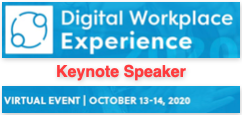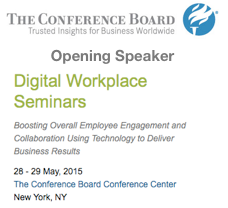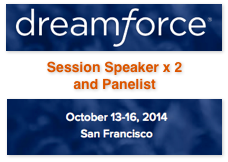What We Know About Making Enterprise Social Networks Successful Today
March 2, 2017 8 Comments
It’s a little hard to believe that it’s been over ten years now since the first early enterprise social networks (ESN) emerged on the market to make their initial forays into our organizations. They showed us then — and I believe even more now today — the bright new possibilities for how we might work together in more innovative and effective ways by becoming fundamentally better connected organizations.
We’ve certainly learned a great deal along the way through thousands of ESN deployments around the world since that time. I have tracked or been involved in a good many of these types of efforts over the years, and so I thought I’d revisit what I believe that we’ve learned so far from the more successful efforts. Sharing this knowledge is vital now, as I still see many practitioners starting almost from scratch. That’s because there is still no single source of knowledge on what works best when it comes to being successful in crafting a next-generation digital workplace with an ESN.
Note: We do have a useful body of industry knowledge now, but it’s currently spread out and must be put together to create a fully integrated picture. The three sources I that think are the most valuable currently are a) the Community Roundtable‘s annual State of the Community Management report, the latest edition of which I explored on ZDNet a little while back, b) Jane McConnell’s excellent Organization in the Digital Age report, and lastly, c) Vanessa Dimauro’s various work at Leader Networks, such as her new Business Impact of Communities report.
Looking in the ESN Mirror: Far Too Much Attention on the Tools
Early makers of enterprise social networks such as Jive, Newsgator, and Socialtext blazed the trail initially, making it possible for workers to engage in truly open and self-organizing collaboration by adapting the social networking model that had worked so well in the consumer world to the enterprise. In particular, these early offerings were based on the early successes of consumer social media and social networking, namely services like Facebook and MySpace, as well highly successful online communities for business like the SAP Community Network. While wikis and blogs were the first genuine contemporary social software used in businesses (groupware, and arguably e-mail were actually the very first social tools), it was the social networking model that ultimately became the leading one.
Eventually, the hard knocks of marketplace competition ultimately led to the domination of the top part of the industry by a few players that executed well: IBM (with Connections and a host of associated platforms), Microsoft (with Yammer, Sharepoint, and now Groups, and probably Teams as well), Salesforce (with Chatter/Community Cloud), and finally Jive as the only truly dedicated enterprise player still standing from the inception of the industry.
But as useful as these platforms were and are in helping enable the right changes in digital workplace mindset and behavior, it was never the technology that was the hardest part. In fact, one of the clearest lessons from the first decade of the rise of the ESN was that virtually all of the major challenges with ESN success are about people, not technology. Making enterprise social networks thrive by fostering stronger, richer connections across organization silos while spurring widespread knowledge sharing and co-creation is an activity that is almost entirely made successful by how you situate the tools among the people involved, what skills you develop amongst them, and the type of goals, encouragement, support, and leadership you establish.
Thus, in the realm of digital collaboration, people come first and technology is second. In fact, I’ve often argued that organizations can actually become effective social businesses without any additional technology at all, like W.L. Gore (10,000 employees, $3.2B revenue) with its famously flat, open and self-organizing culture which was a social businesses long before the technology arrived. (They have since adopted the ESNs as one of their core tools.)
A Signature Lesson: People Must Change with the Tech, So Guide Them
I’d even go as far as to say this (to borrow a concept from the Internet of Things): The enterprise social network actually creates a side-by-side virtual “twin” of your organization, one that is more natural, organic, collaborative, scalable, and self-organizing. The digital twin represented by your ESN must therefore be nurtured in the same way as your business is (because it is the business too.)
Just like you’d never let your organization operate without a well-articulated vision, a relentless focus on growth and development, regular investment in better performance, careful strategic oversight, and passionate involvement by leadership as well as the rank and file, your ESN can’t lack for these elements either.
Thus, here’s the short list of the top factors I now believe drive success with enterprise social networks today. By and large, these factors are not technological in nature, though they often are highly reflective of — and can be directly aided by — the technology environment in which they operate. Instead these success factors represent the foundational types of human activities and skills that helps organizations more readily tap into the increasingly well understood benefits of operating as a social business. Lack more than a couple of these factors, and your ESN isn’t likely to be much of an improvement over say, an e-mail or unified communications system, in terms of the truly differentiated impact it can have.
The Hard Won Lessons of Thriving ESNs
- Purposeful use case design. Unlike generic communications systems, enterprise social networks perform at their best when they’re designed around specific business activities. While having user profiles, activity streams, groups, and posts at a basic level is useful in itself — and that’s what ESN platforms offer out of the box — it’s designing for specific use cases like budgeting, recruiting, supply chain exception management, and dozens of other key activities where the real business value and impact comes in. For example, I am seeing a strong push in many ESN efforts this year to help teams collaborate more effectively in the field, particularly with sales teams, as that function matters a great deal to most businesses and is one of the best ways to demonstrate value early on. But the user experience of the ESN must be extended to natively support these use cases and make them better. This generally means bespoke experiences that extend and expand the ESN to realize the highest value use cases in an optimized way, instead of hoping that generic, out-of-the-box ESN functions will somehow enable them. While most ESN platforms have tools and APIs that make this relatively straightforward, I find that most practitioners expect that their ESN will do most of what is needed out of the box.
This is simply not the case today. In fact, some of the most compelling examples of ESN solutions are found when specific high impact use cases are enabled through purposeful design, such as with custom-designed Plus Relocation’s Elo community, which lies at the very core of how they run their business, or the Milwaukee School of Engineering’s Bridge platform, which greatly accelerates the admission process via a carefully designed and gameified experience. All of this began to be understood back in 2011 when a widely discussed post by Laurie Buczek noted from her efforts at Intel were far too disconnected from the actual work of the business to matter very much. Well-known analysts in the ESN space such as Constellation’s Alan Lepofsky identified purposeful collaboration as a key success factor back in 2013. Attached below are a sample of the some of the functional use cases that enterprise social networks can be dramatically improved through open collaboration, which I’ll be exploring in more detail soon:

- Professional community management. I am sometimes surprised how often I still encounter a poor appreciation of the vital importance of capable community management — see TheCR’s skill wheel to understand how involved a job it is — in ensuring the long-term growth and success of an ESN. Last year I even wrote an open letter, aimed at the IT department which often does the technology implementation for an ESN (and gets charged about half the time with actually operating it), about the criticality of developing this strategic social business capability. Short version: Digital communities are a new type of entity requiring a new form of support and enablement. Do not use interns for this, don’t use the inexperienced, don’t add it to someone’s already busy day job. Instead, use experienced professionals, like you would with any other important business function. Outsource if you have to (what I call Community Management as a Service.) Invest early and plan for the long hual as the Community Roundtable has correlated it directly with the maturity level of an ESN effort.
- Working out loud. Of all the digital skills that workers should be developing now, perhaps the one that most naturally is an onramp to most of the others and leads to both positive outcomes and compelling emergent results is the act of working out loud (WOL) in digital channels. John Stepper’s Working Out Loud book and his push for organizations to create WOL circles to build skills around the technique is probably the best place to start. My industry colleague Michelle Ockers recently posted some fascinating insights into how WOL can work with actual results from a large organization. In short, working out loud will develop vital network leadership skills, cultivate social capital, and produce higher level of knowledge sharing, collaboration, and institutional knowledge, to name just a few of the benefits by virtue of simple and straightforward daily activities in the ESN.

- Network leadership. As organizations become more virtual, decentralized, and digitally-enabled, it will be in social tools that leadership will soon be wielded most effectively. Managing our organizations through digital networks has become an essential skill, just not one that we’re training for in most organizations yet, and now we must. The majority of ESN deployments spend very little time developing these skills or educating team leaders, managers, and executives in the basic skills of network leadership, yet are often surprised when highly meaningful and impactful activity to the organization doesn’t take place there.
- Digital collaboration skill development. In general, organizations are not developing the human skills as much as they are developing their digital workplace technologies. Almost every ESN effort I have encountered is under-delivering in some way on building the new skills required to get the most from social collaboration, as it depends on very different thinking such as letting the network do the work and designing your work processes for loss of control. These needn’t be — and shouldn’t be — complex digital skill education programs. Collaborate with your learning and development team and build some lightweight digital collaboration skill development content (videos, quick starts), add ESN education to new hire onboarding, cultivate WOL circles, and then evangelize and educate at every opportunity across the organization.
- Supportive and engaged senior stakeholders. Perhaps the fastest and most effective way to get traction and sustain success with an ESN is to have active and fully participative leadership. This means both support and sponsorship as well as active presence in the enterprise social network itself. One of the first thing ESN practitioners should focus on is landing at least two senior executives willing to lend their reputation and standing in the organization to the effort. How important is this really? In the Community Roundtable’s survey data, year-after-year, it generally comes in as a top two factor, so it’s high on the importance scale.
- Guardrails on activities that impede being a connected company. There are some easy ways that organizations can inadvertently reduce the benefits of social collaboration. One of the top ones is making it too easy to create private groups in the ESN. This is easy to remedy, if you’re aware of it: Leading social business exemplars like Bosch require users to submit a business case for private groups as a “tax” to place friction on keeping information hidden. Not retiring aging digital channels that are less open and participative can also be factor, as workers will initially tend to gravitate back to the tools and channels they know. In general, be diligent in not breaking FLATNESSES, which is a more detailed mnemonic I adapted from Andrew McAfee’s initial SLATES mnemonic describing what makes social tools different and more powerful than what came before.
ESNs are about people + digital technology: Focus in that order
Are there other success factors? Sure, and they vary widely depending on the organization, its culture, inclinations, and level of digital competency. If you want a deeper drive, I previously explored in detail, by pulling from several dozen client studies and industry case examples, what early adoption success patterns for ESNs were, since that phase was what most organizations were focused on then. We’ve learned some additional lessons since then — most of which are summarized above — but it’s still a useful breakdown if you need more techniques to drive success.
Does all of this sound overly complex? Not really. Social technologies themselves are getting very good at making the fundamentals easier, while there is a growing body of knowledge that can be used as a template for the structures and processes one needs to put into place. I’ve previous explored the structure side several times, both in terms of specific roles and organizational capability, while the process side is well-depicted in aforementioned community manager skill wheel.
In short, never before has it been easier to adopt enterprise social networks and achieve significant impact. It just takes a focus on what matters most, which is a steady choreography that consists of shifting human skills and supporting collaboration technologies together towards business goals. I now believe that most organization can get to ESN success quickly and repeatably, but only if they assess and adequately address the full dimension of people and technology concerns required.
Additional Reading
How Social Technology has Emerged as an Enterprise Management Model




























































Thanks for this fine synopsis, Dion! I’ll forward it to our ESN to spread the word…
Thanks for the spreading the word. Would love to hear how your ESN is going as well. Any significant lessons you can share?
Great article and thought leadership here. Thanks for the shout out!
Pingback: Dion Hinchcliffe: What We Know About Making Enterprise Social Networks Successful Today – How to be a leader in #service: #servicedesign and #designthinking
Hi Dion-
Thanks for sharing this
As our thinking continues to converge, I continue to push for business outcomes as the primary objective of social enterprise concepts including ESNs. So, I am glad to see your first lesson focused on “purposeful use case design.”
Great article Dion. It still amazes me how long it takes organisations to realise that this is all about the people + appropriate application of enabling digital technology capabilities and that we must focus in that order. For me it all starts with ensuring you are addressing priority user needs (i.e. use cases) and not standing up tech for tech sake. Your reference to the importance of Community Management and the CR is huge too..
Really well done, something technologists and business leaders can process. Also appreciate all the links, and having the urls spelled out.
Pingback: Top 50 Most Influential Blogs and Thinkers in Cloud Computing today - zsah